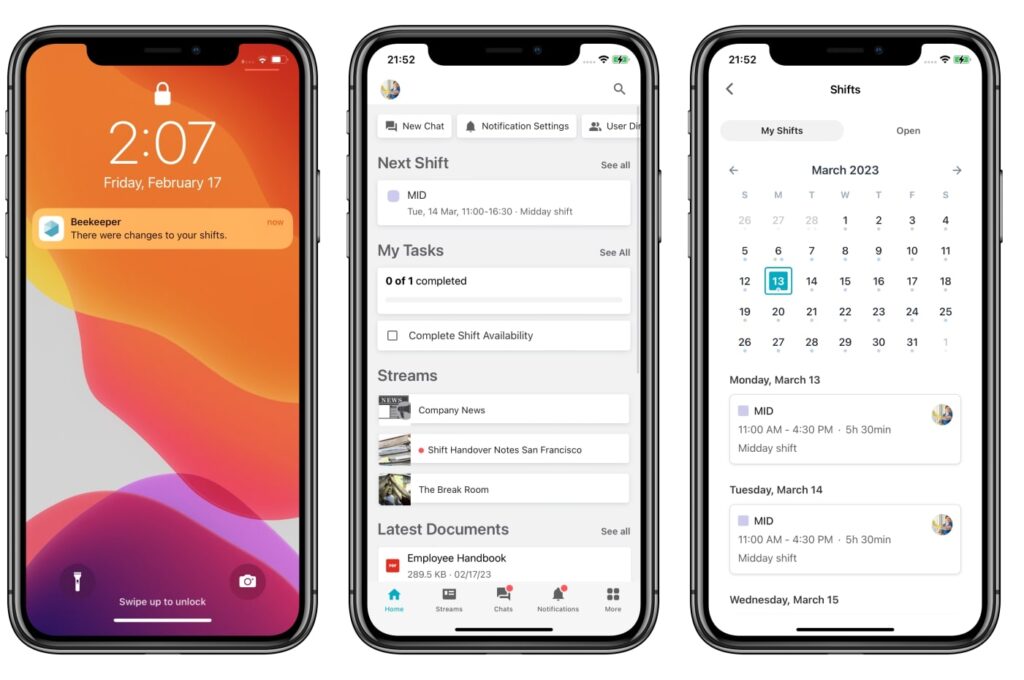Mastering Shift Coverage: Strategies and Solutions for Improved Operations

If you’re a shift schedule manager or business owner, do any of these sound familiar?
- You’re tired of dealing with last-minute call-offs and struggling to find coverage for shifts
- You find it challenging to distribute shifts evenly and avoid understaffing
- You’re concerned about the negative impact these issues could have on service quality and employee morale
Fill shifts faster with Beekeeper. Learn more
Last-minute call-offs can wreak havoc on your operations, leaving you scrambling to find someone to fill the shift. This not only disrupts your workflow but also puts additional stress on your staff. Uneven shift distribution can lead to some employees feeling overworked while others have lighter schedules, causing resentment and dissatisfaction among your team. When you don’t have enough staff scheduled, it not only affects your ability to provide quality service but also increases the risk of employee burnout and turnover.

Mastering shift coverage means improving operational efficiency and increasing employee satisfaction, ultimately leading to reduced turnover. Distributing shifts evenly helps to avoid understaffing and ensure that your team is well-equipped to provide quality service.
At Beekeeper, we’ve worked with many frontline organizations trying to improve shift coverage and understand the complexities of scheduling. That’s why we have developed practical strategies, tools, and insights to help you overcome these obstacles and optimize shift coverage.
By the end of the article, you’ll be better equipped to ensure seamless coverage, enhance business performance, and improve workforce morale.
The Challenges of Shift Coverage
Let’s look at the three main challenges that come up in shift management:
- Last-minute call-offs: Whether it’s due to illness, personal emergencies, or other unforeseen circumstances, employees sometimes need to cancel their shifts at the last minute. This can leave shift managers scrambling to find a replacement and can disrupt the entire team’s schedule. It not only causes stress and frustration for you as the manager but also puts additional pressure on your other employees who may need to fill in.
- Uneven shift distribution: It can be difficult to create a schedule that is fair and balanced for all employees. Some may end up with more shifts than others, leading to feelings of resentment and dissatisfaction among your team. This can negatively impact morale and ultimately affect the overall performance of your organization.
- Understaffing: If you don’t have enough employees scheduled for a particular shift, it can lead to increased workload and stress for those who are working that shift. This can also result in decreased service quality, as employees may not have enough time or resources to effectively handle all tasks and responsibilities.
These challenges can have a significant impact on your business, leading to employee burnout, increased turnover, and a decline in customer satisfaction. By implementing effective strategies and utilizing tools to optimize shift coverage, you can overcome them.
Before we dive into some practical tips and templates, let’s look at why shift coverage matters.
Reasons Why Shift Coverage is Important
Shift coverage is vital for any business that operates on a shift-based schedule. Shift coverage ensures that all necessary tasks and responsibilities are covered at all times, enabling the organization to provide consistent and efficient service to customers.

Shift coverage impacts:
- Continuity of operations: When there are no gaps in service, organizations can operate smoothly and know that there are always employees available to handle continuous tasks like customer inquiries, processing transactions, and addressing any issues that may arise.
- Employee well-being: Adequate shift coverage ensures that employees are not overwhelmed with excessive workloads and stress. It factors in breaks and time off, preventing burnout and promoting work-life balance. When employees are well-rested and have manageable workloads, they are more productive, motivated, and likely to provide quality service.
- Emergency readiness: Shift coverage is crucial during emergencies or unforeseen events. Whether it’s a power outage, a medical emergency, or a natural disaster, having staff on hand ensures that the business can respond effectively and minimize any disruptions. Employees can also assist in evacuations or other emergency procedures, ensuring the safety of customers and fellow employees.
- Flexibility and adaptability: Shift coverage allows businesses to be flexible and adapt to changing demands and market conditions. It enables them to adjust schedules based on peak hours, seasonal fluctuations, or unexpected events. This flexibility ensures that the business can efficiently allocate resources to meet customer needs, regardless of the time of day.
Now let’s look at some common shift coverage types and how they apply to frontline teams.
Top 5 Common Shift Coverage Types and Templates
There are various shift coverage types, each with its own advantages and suitability for different industries. Let’s explore five common shift coverage types and how they can apply to frontline organizations:
1. DuPont Schedule
The DuPont Schedule, also known as the 12-hour rotating shift schedule, is commonly used in industries requiring continuous operations, such as manufacturing or healthcare. This schedule consists of 12-hour shifts, with a pattern of two to four days on, followed by two to four days off. This allows for longer periods of rest between shifts and reduces the number of shift changes, which can improve employee well-being and productivity.
Here’s an example template for a DuPont Schedule in a manufacturing plant:
- Week 1: Monday, Tuesday (on), Wednesday, Thursday (off), Friday, Saturday, Sunday (on)
- Week 2: Monday, Tuesday (off), Wednesday, Thursday (on), Friday, Saturday, Sunday (off)
2. 2-2-3 Schedule
The 2-2-3 schedule is commonly used in industries where operations require employees to work both weekdays and weekends, such as retail or customer service. It involves two consecutive days on, followed by two consecutive days off, and then three consecutive days on. This rotation allows employees to have regular weekends off, providing work-life balance and consistency in scheduling.
Here’s an example template for a 2-2-3 Schedule in a retail store:
- Week 1: Monday, Tuesday (on), Wednesday, Thursday (off), Friday, Saturday (on), Sunday (off)
- Week 2: Monday, Tuesday (off), Wednesday, Thursday (on), Friday, Saturday, Sunday (on)
3. 4-on-4 Schedule
The 4-on-4 schedule is commonly used in industries that require employees to work longer shifts over fewer days, such as emergency services or transportation. Employees work four consecutive days, typically 10-12 hours per shift, followed by four consecutive days off. This schedule allows for extended periods of rest and can be beneficial for preserving employee energy and work-life balance.
Here’s an example template for a 4-on-4 Schedule in a hospital:
- Week 1: Monday, Tuesday, Wednesday, Thursday (on), Friday, Saturday, Sunday, Monday (off)
- Week 2: Tuesday, Wednesday, Thursday, Friday (off), Saturday, Sunday, Monday, Tuesday (on)
4. Split Shift Schedule
The split shift schedule is commonly used in industries that require coverage during peak hours, such as restaurants. It involves dividing the workday into two separate shifts, with a break in between. This schedule allows organizations to have coverage during busy periods while offering employees flexibility in their daily routines.
Here’s an example template for a Split Shift Schedule in a restaurant:
- Morning Shift: Monday to Friday, 8:00 am to 12:00 pm
- Break: Monday to Friday, 12:00 pm to 2:00 pm
- Afternoon Shift: Monday to Friday, 2:00 pm to 6:00 pm
5. Fixed Shift Schedule
The fixed shift schedule is commonly used in industries with consistent demand throughout the day, such as hospitality. It involves assigning employees to specific shifts that remain the same over a designated period, such as a week or month. This schedule provides stability for employees, allowing them to plan their personal lives around their work hours.
Here’s an example template for a Fixed Shift Schedule in a hotel:
- Morning Shift: Monday to Friday, 7:00 am to 3:00 pm
- Afternoon Shift: Monday to Friday, 3:00 pm to 11:00 pm
- Night Shift: Monday to Friday, 11:00 pm to 7:00 am
Now that we’ve covered different types of shift schedules, let’s look at strategies for choosing the right scheduling strategy.
10 Tips to Choose the Right Shift Coverage Schedule for your employees
Choosing the right shift coverage schedule for your employees is crucial for maintaining productivity, employee satisfaction, and seamless operations. Here are ten tips to help you make an informed decision:
1. Think About Staffing Needs
Consider the specific requirements of your business and the demand for coverage during different hours. Analyze peak times, busy periods, and any special events that may require additional staff. This will help you determine the number of employees needed for each shift.
2. Consider Employee Needs and Preferences
Take into account the needs and preferences of your employees when designing the shift schedule. Some may prefer working during specific hours or on certain days, while others may have personal commitments that need to be considered. Employee input is valuable in ensuring a schedule that works well for everyone.
3. Balance Workload and Breaks
Make sure that the workload is evenly distributed throughout the shifts and that employees have adequate breaks. Avoid scheduling too many consecutive shifts or long hours without rest. Striking a balance will prevent burnout and maintain employee well-being.
4. Evaluate Employee Availability
Understand the availability of your employees and their desired hours of work. Some may have restrictions due to other commitments or responsibilities, such as childcare or education. By considering their availability, you can create a schedule that accommodates their needs as much as possible.
5. Assess The Impact on Employee Health
Different shift schedules can have varying effects on employee health and well-being. Take into account factors like sleep patterns, circadian rhythms, and the potential for fatigue. Avoid sudden shift changes or rotating schedules that may disrupt employees’ internal body clocks.
6. Consider Overtime and Shift Differentials
If your business requires employees to work beyond their regular scheduled hours or during weekends, consider offering overtime pay or shift differentials. This can incentivize employees to take on additional shifts and ensure coverage during critical times.
7. Plan For Contingencies
Create a contingency plan for unexpected absences or emergencies. Establish a system for employees to request time off or swap shifts, ensuring that there is always coverage even in unforeseen circumstances.
8. Communicate the Schedule in Advance
Provide employees with the shift schedule well in advance, allowing them to plan their personal lives around their work hours. Clear communication can help reduce confusion, improve attendance, and enhance overall employee satisfaction.
9. Test and Evaluate
Consider implementing a trial period for the chosen shift coverage schedule to assess its effectiveness. Collect feedback from employees and monitor productivity levels during the trial phase. Then make necessary adjustments based on the feedback received.
10. Choose the Right Shift Scheduling Tools
Effective shift scheduling software streamlines the scheduling process, minimizes errors, ensures optimal shift coverage, and improves communication. This leads to better resource allocation, reduced costs, and increased efficiency.
Beekeeper’s Shift Schedules tool offers a comprehensive solution to streamline this process. With instant access to work schedules on their mobile devices, frontline employees no longer have to rely on outdated printed schedules or bulletin boards. They can easily check their shift schedules, view important details, and receive push notifications for any changes or additions.
Beekeeper’s Shift Schedules tool in action
For shift managers, Beekeeper’s Shift Schedules tool simplifies the entire scheduling process. They can create and manage schedules in real time, approve shift changes, and collect employee availability efficiently. The tool also allows integration with existing scheduling tools, reducing the need for manual data entry.
The benefits extend beyond convenience. Our tool helps improve communication and reduce absenteeism by ensuring employees are well-informed and notified of any changes. It also promotes stability and flexibility in work schedules, reducing burnout and increasing employee morale. Beekeeper also facilitates effective shift handover, ensuring task completion and maximum productivity.
Best of all, Beekeeper is a frontline success system that offers a user-friendly interface, real-time updates, and a range of features designed to optimize shift coverage (and more) and enhance overall operational efficiency.
Fill shifts faster with Beekeeper. Learn more
Optimizing Your Shift Coverage for Success
Let’s recap some key strategies to consider if you want to optimize your shift coverage for success.
- First, analyze your organization’s peak hours and busy periods to determine when you need the most coverage. This will help you allocate the right number of employees to each shift.
- Second, take into account the availability and preferences of your employees. Consider their desired hours of work and any personal commitments they may have. By accommodating their needs as much as possible, you can improve employee satisfaction and retention.
- Also, ensure that the workload is evenly distributed throughout the shifts and that employees have adequate breaks. Balancing workload and rest periods will prevent burnout and maintain productivity.
Lastly, communicate the shift schedule well in advance and be open to feedback and adjustments. This will allow employees to plan their personal lives around their work hours.
By implementing these strategies, you can optimize your shift coverage for success, leading to improved productivity, employee satisfaction, and seamless operations.

About the author
Beekeeper
We make frontline lives easier, work safer, and teams more connected so businesses can reach new heights. At Beekeeper, we’re dedicated to making frontline lives easier by connecting workers with the tools, support, and information they need to feel valued, do their best work, and drive the business forward.







